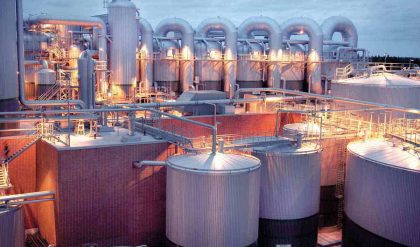A thermodynamic (physical or chemical) process may be defined as the pathway of series of intermediate changes that occur when a system is changed from initial to final state. Processes starting with the same initial state and ending at different final states correspond to different thermodynamic processes.
Different types of processes are commonly used in the study of thermodynamics.
Isothermal process is defined as one in which the temperature of the system remains constant during the change from its initial to final states. During the isothermal process, the system exchanges heat with its surroundings and the temperature of system remains constant.
Adiabatic process is defined as that one which does not exchange heat with its surroundings during the change from initial to final states of the system.
A thermally and completely insulated system with its surroundings can have changes in temperature during transformation from initial to final states in an adiabatic process. This is because, the system cannot exchange heat with its surroundings.
Isobaric process is that process in which the pressure of the system remains constant during its change from the initial to final state.
Isochoric process shows no change in volume of system during its change from initial to final state of the process.
Cyclic process: The process which brings back the system to its original or initial state after a series of changes is called as cyclic process.
Spontaneous process are those that occur on their own accord. For example heat flowing from a hotter end of a metal rod to a colder end. In these processes, the transformation of the system from initial, to final state is favourable in a particular direction only. Many of the spontaneous processes are natural processes and are also, irreversible processes.
Non-spontaneous process are those that does not occur on their own accord. For example, although carbon burns in air evolving heat to form carbon dioxide, on its own carbon does not catch fire and an initial heat supply is required. Since many of the non-spontaneous processes are slow processes, they also exist as equilibrium processes.
Reversible process. In a reversible process the series of changes carried out on the system during its transformation from initial to final state may be possibly reversed in an exact manner.
This is possible when the changes are carried out very slowly in many smaller steps on the system during its change from initial to final state. By doing so, each of its intermediate state will be in equilibrium with its surroundings. Under such conditions the initial and final states of the system become reversible completely.
For example, when ice melts a certain amount of heat is absorbed. The water formed can be converted back to ice if the same amount of heat is removed from it. This indicates that many reversible processes are non-spontaneous processes also.
Irreversible Process
An irreversible process is one which cannot be retraced to the initial state without making a permanent change in the surroundings. Many of the spontaneous processes are irreversible in nature.
For eg. Biological ageing is an irreversible process. Water flowing down a hill on its own accord is an irreversible process.
Some of the characteristics of thermodynamically reversible and irreversible processes are compared as below:
Reversible process
It is a slow process going through a series of smaller stages with each stage maintaining equilibrium between the system and surroundings.
2. A reversible process can be made to proceed in forward or backward direction.
3. The driving force for the reversible process is small since the process proceeds in smaller steps.
4. Work done in a reversible process is greater than the corresponding work done in irreversible process.
5. A reversible process can be brought back to the initial state without making an change in the adjacent surroundings.
Irreversible process
1. In this process the system attains final state from the initial state with a measurable speed. During the transformation, there is no equilibrium maintained between the system and surroundings.
2. Irreversible process can take place in one direction only.
3. There is a definite driving force required for the progress of the irreversible process.
4. Work done in a irreversible process is always lower than the same kind of work done in a reversible process.
5. An irreversible process cannot be brought back to its initial state without making a change in the surroundings.
Exothermic and endothermic processes
When the thermodynamic process is a chemical reaction or a physical transformation, process is classified as either exothermic or endothermic depending on the nature of heat involved in the over all process. These two processes are differentiated as follows:
Endothermic process
A process when transformed from initial to final states by absorption of heat is called as an endothermic process.
2. The final state of the system possesses higher energy than the initial state. The excess energy needed is absorbed as heat by the system from the surroundings.
3. Generally in a physical transformation which is endothermic heat is supplied to bring about the initial to final state.
Example: melting of a solid by supplying heat is an endothermic process.
Exothermic process
1. A process when transformed from initial to final states by evolution of heat is called as exothermic process.
The final state of the system possesses lower energy than the initial state. The excess energy is evolved as heat. Example: All combustion processes are exothermic.
If the physical transformation is exothermic heat is removed to bring about the initial to final state.
4. Example: Freezing of a liquid at its freezing point is an exothermic process.


Comments are closed.